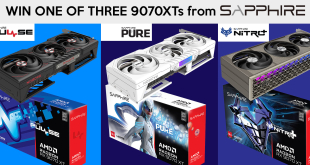The Sapphire R7 250 Ultimate is designed for a very specific enthusiast audience. Those people who want a silent system, and the audience building a low cost media center with a need for video acceleration, high image quality and a secondary demand for casual gaming duties.
The Sapphire R7 250 Ultimate is fan less. In real world terms this means that it produces no noise at all. Additionally, it doesn't require power from a PCI-e connector, getting all the juice it needs direct from the PCIe slot on the motherboard. If you are building a system into a small chassis, this can help with cable routing.
When dealing with a fan less graphics card, it is important to ensure that the computer chassis has some air flow, to help expel hot air. Sapphire include a heat warning sticker on the heatsink of the Ultimate cooler and we can confirm it does get really hot after a modest gaming session.
Without any air flow next to the graphics card, this hot air would rise inside the chassis, potentially raising temperatures for all the other key components. In a small, space restricted media center chassis, this issue would be even more of a concern.
Sapphire's R7 250 sits almost exactly between a pair of popular nVidia cards. Considering there is only £15 separating the GT640 (£64.96 inc vat) and GT650 (£79.65 inc vat), the performance differences are extremely noticeable between the two Nvidia cards. We would go as far to say that for high definition gaming, the GT640 is close to useless – unless you were happy running with low image quality settings. The GT650 on the other hand is an excellent graphics card, offering solid frame rate performance for less than £80.
For gamers dealing with a restrictive budget, the R7 250 offers decent performance for around £70 – it very closely matched against the more expensive Nvidia GT650. More serious gamers will need to spend a little extra cash to get smooth frame rate performance at 1080p. If you have around £100-£110 to budget for a new graphics card, then we recommend either the AMD R7 265 or the newly released Nvidia GTX750 Ti. Both are excellent solutions and offer a considerable performance boost over the R7 250, but at a cost.
You can discuss on our Facebook page, over here.
Pros:
- decent performance at 720p.
- silent.
- HDMI cable included in bundle.
- good price point.
- does not require a PCIe connector.
- some overclocking headroom, although we advise good surrounding airflow.
- very low demand on a power supply.
Cons:
- Without supporting air flow, hot air from the heatsink will rise inside the case.
- Will not be powerful enough for the latest Direct X 11 titles at 1080p.
- Not single slot.
Kitguru says: A well designed, competitively priced solution for gamers on a strict budget.

 KitGuru KitGuru.net – Tech News | Hardware News | Hardware Reviews | IOS | Mobile | Gaming | Graphics Cards
KitGuru KitGuru.net – Tech News | Hardware News | Hardware Reviews | IOS | Mobile | Gaming | Graphics Cards



no single slot? well that sucks… HTPC users need single slot cards.
Harris, AMD cards output a lot of heat, building this into a single cooler design would be not feasible, based on the temperature results Kitguru recorded.
AMD need the Maxwell architecture for this. I am surprised Nvidia haven’t released a single slot passively cooled MAXWELL based card, but I am sure it is coming soon.
Including the previous Sapphire Ultimate (HD 7750) in the test comparisons would have be very helpful. Next time?